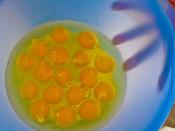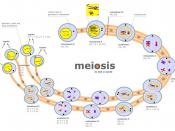Meiosis is the process in sexually reproducing organisms where cells divide.
The cells produced during meiosis have half the chromosome number as the
original cell. There are two cell divisions in meiosis, meiosis l and meiosis
ll. These cell divisions produce 4 hapolid daughter cells. Haploid cells contain
only one set of chromosomes, which is written as n. Meiosis consists of nine
phases.
In meiosis the interphase l the chromosomes replicate and the centrosome
duplicates in one diploid cell. Diploid cells have two sets of chromosomes, they
received one from each parent. During prophase l the nuclear envelope fragments
and spindle microtubules form between the centrosomes. Homologous chromosomes
pair to make two sister chromatids. This is called synapsis. Chromatids of
homologous pairs exchange segments when they cross over. At metaphase l, the
pairs line up on the metaphase plate. Microtubules from one pole attach to the
kinetochore of one homologous chromosome, while microtubules from the other pole
attach to the kinetochore of the other pair.
During anaphase l the microtubules
get shorter pulling the homologous pairs towards opposite poles. At telophase l
two haploid cells form but the chromosomes are still double.
Meiosis ll separates the sister chromatids. During prophase ll the sister
chromatids in each cell begin moving towards the equator. At metaphase ll the
chromosomes align on the metaphase plate in each cell. The process of anaphase
ll pulls the sister chromosomes to opposite poles in each cell. During telophase
ll each cell forms a nuclei and cytokinesis splits the cells apart. Four
genetically different haploid cells are produced.
Independent assortment is differences between the genes. Variation can occur
in meiosis when the chromosomes cross over and during random fertilization.
Random fertilization is when a gamete from the mother unites with the haploid
from the father to...



Quite OK
It was quite informative, but you should fix the layout of your text because it is annoying to read it when the distances between the sentences is big. You should also have a conclusion and introduction. Otherwise it was ok
0 out of 0 people found this comment useful.